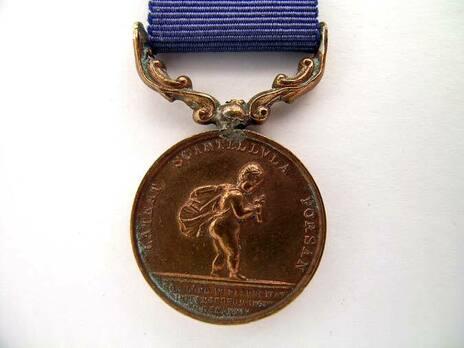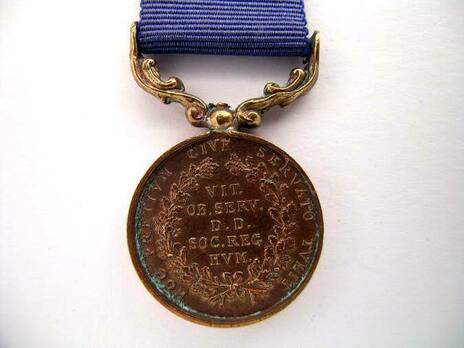Royal Humane Society Medal, in Bronze (for "unsuccessful" rescues, 1837-1867)
CATEGORY: Version
SKU: 02.GBR.0549.103.01.001
Estimated market value:


Estimated market value:
The Royal Humane Society Medal was established in 1774. The Medal was initially awarded to personnel in recognition of life-saving acts or attempts to save a life from drowning. The award of the Medal was later expanded to reward all acts of exceptional bravery in rescuing or attempting to rescue persons from mines, wells, blasting furnaces, or in sewers. The Medal is issued in Gold, Silver, and Bronze.
There are multiple versions of the Medal. Between 1774 and 1837, the Medal was issued in Gold and Silver in a large size. Only 13 Gold Medals were awarded to honorary members in recognition of non-life saving acts. In 1837, a large Bronze Medal was introduced to reward life-saving acts. These large Medals, later referred to as Medals for "successful" rescues, feature a Latin inscription on the reverse which translates to "He Has Obtained this Reward for Saving the Life of a Citizen."
Also in 1837, a large Bronze Medal was issued to reward unsuccessful rescue attempts. The large Bronze Medals for unsuccessful rescues omit the Latin reverse inscription seen on the large Medals for life-saving. The large Medals for successful and unsuccessful rescues features an inscription of the recipient's name and date of the recognized act on the reverse.
Since 1867, the Medal has been issued in a small Silver and Bronze version to reward both successful and unsuccessful rescues. The small Medal for successful rescues features a reverse Latin inscription which translates to "The Royal Humane Society Presented this Gift for Saving Life," while the small Medal for unsuccessful rescues features a reverse Latin inscription which translates to "The Royal Humane Society, His Life Having Been Exposed to Danger." The small Medal features the recipient's name and details of the recognized act engraved on the rim.
Between 1869 and 1950 silver and bronze clasps, corresponding to the previous award, were awarded to denote subsequent acts of bravery deserving of a Medal.
There may be additional versions of the Medal.

Comments
Sign in to comment and reply.


Scroll Top